Little Henry Holdsworth had worse skin than a spotty teenager – but, within 24 hours of using the products, his blemishes had disappeared.
A mum whose newborn was so coated in acne his skin looked worse than a spotty teenager’s revealed how the plague of blemishes miraculously cleared within 24 hours of using a £7.99 pot of coconut oil.
Click to Gallery
Little Henry Holdsworth had worse skin than a spotty teenager – but, within 24 hours of using the products, his blemishes had disappeared.
She said: “His entire body was covered in acne. He had proper whiteheads, like a spotty teenager.
Alex, whose husband Ben, 34, is a managing director, told how Henry’s big brother, Freddie, four, also broke out in acne at around three weeks old – although it was only on his cheeks.
She continued: “I ended up just washing his face every day with water.
Eventually, Freddie’s acne cleared up on its own when he was a few months old, and Ben and Alex soon welcomed another son, Charlie, now two, into the world – who, thankfully, did not get acne, although he had some mild eczema.
Once again, she tried using breast milk as a cleanser – but it made no difference.
At the end of her tether, Alex was chatting to a friend one day when Kokoso was mentioned for the first time.
After that, Alex ordered a pot of coconut oil for herself, as well as baby hair and body wash.
Now, Alex continues to use the products to keep Henry’s spots at bay and has also found them useful for Charlie’s eczema – as well as improving her own complexion.
Little Henry Holdsworth was just three weeks old when his stay-at-home mum Alex, 31, first noticed red blemishes springing up on his cheeks – swiftly followed by spots covering his entire body, including several whiteheads on his face.
After trying a multitude of remedies, even washing his face in breast milk after reading an online tip, to no avail, Alex, of Kettering, Northamptonshire, was recommended a simple coconut oil from a baby skincare range – and within a day Henry’s skin was clear.
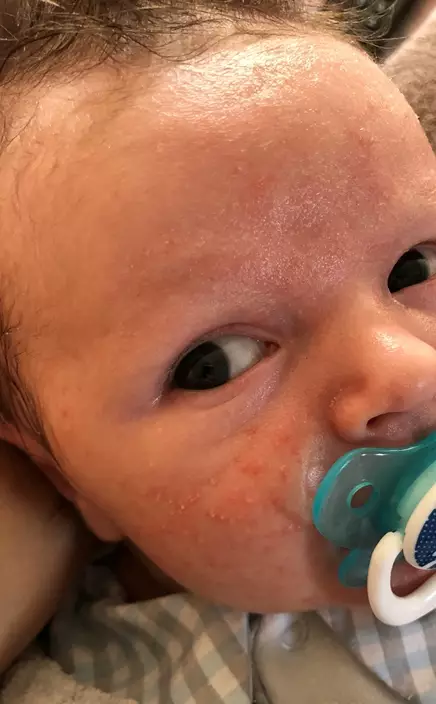
Henry at five weeks old, with acne (PA Real Life/Collect)
She said: “His entire body was covered in acne. He had proper whiteheads, like a spotty teenager.
“The acne was clearly irritating him, too, as he’d scratch so much he’d bleed. When I first heard about the oil, made by a brand called Kokoso, I wasn’t sure.
“Oil is something I cook a fry up with, so I thought it’d clog his skin even more, but I figured it was worth a try and couldn’t believe it when I could see the redness disappearing before my eyes.”
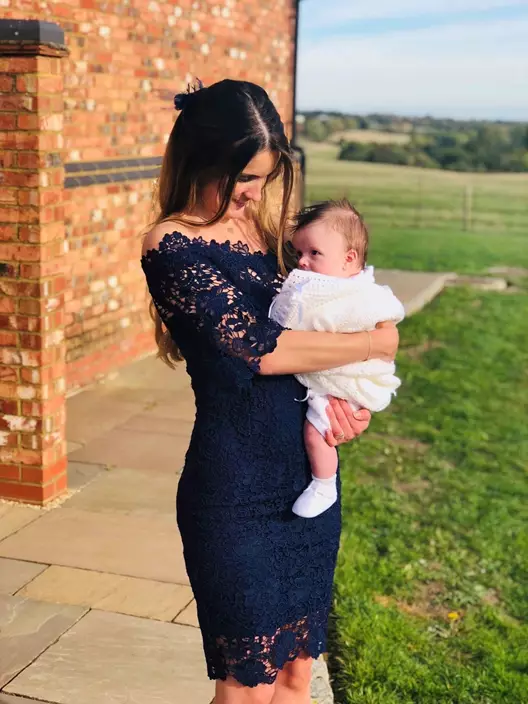
Alex with Henry and his Christening (PA Real Life/Collect)
Alex, whose husband Ben, 34, is a managing director, told how Henry’s big brother, Freddie, four, also broke out in acne at around three weeks old – although it was only on his cheeks.
“It was really quite bad,” she said, recalling how she had discovered the breast milk tip online, reading that its soothing, antibacterial properties could effectively clear spots.
“It didn’t have much of an effect, though. It dried his spots out, but the redness remained, and then the milk would go all crusty.”

Alex introducing Henry to Freddie and Charlie (PA Real Life/Collect)
She continued: “I ended up just washing his face every day with water.
“I was a first time mum with this perfect baby, who all of a sudden, was covered in acne. In the world we live in today, you do feel paranoid about nasty comments, and I was worried what people would say.
“When we went out, I’d see strangers staring at him, not knowing whether or not to say something.”

Henry now, with clear skin (PA Real Life/Collect)
Eventually, Freddie’s acne cleared up on its own when he was a few months old, and Ben and Alex soon welcomed another son, Charlie, now two, into the world – who, thankfully, did not get acne, although he had some mild eczema.
But when Henry was born in August this year, spots erupted on his face when he was a few weeks old.
Former restaurant manager Alex explained: “I wasn’t expecting it this time, as Charlie hadn’t had it, so when I saw the acne start I thought, ‘Oh god.’”
She added: “Then he woke up one morning totally covered. It was all over his entire body, especially his torso.
“I was worried it was something more, as it looked very rash-like, so I took him to the doctors but was reassured that it was just acne.”
As Henry’s case was so much more severe than Freddie’s, Alex didn’t want to simply wait for it to clear up on its own.
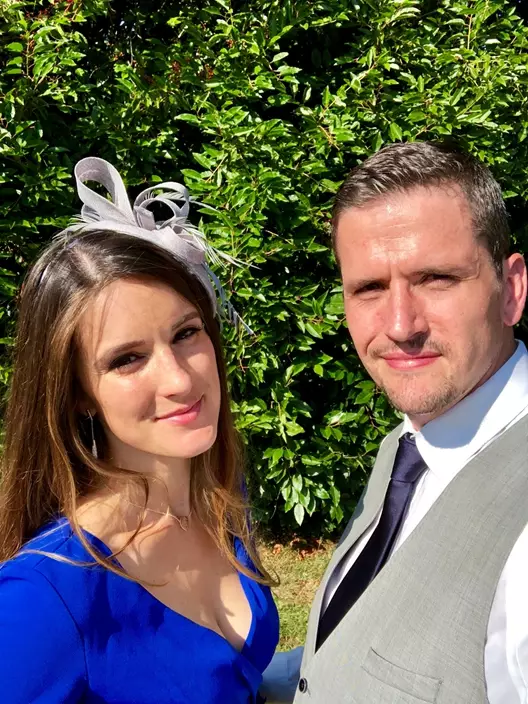
Alex and her husband Ben (PA Real Life/Collect)
Once again, she tried using breast milk as a cleanser – but it made no difference.
Meanwhile, driven to distraction by itching, little Henry would scratch at his face, leaving his skin marked and bleeding.
“We had to put him in mittens in the end,” said Alex. “He got all these proper whiteheads too. You could see how deep they were.”
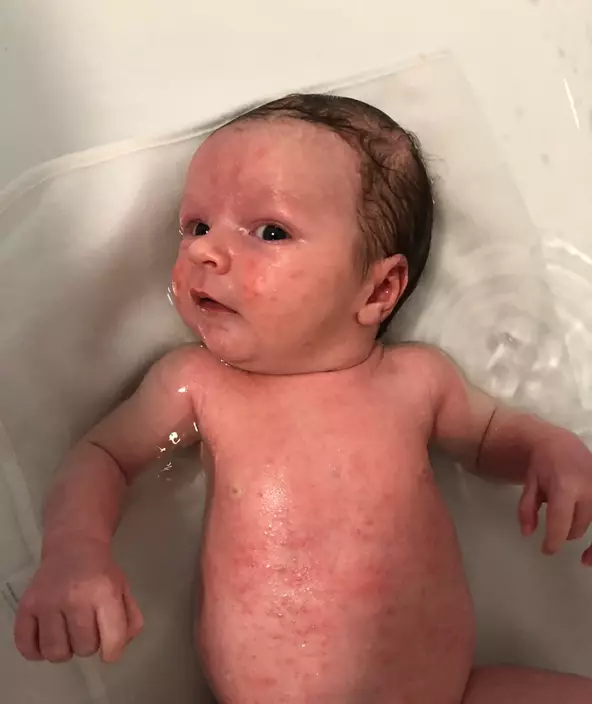
Henry's whole body was covered in acne (PA Real Life/Collect)
At the end of her tether, Alex was chatting to a friend one day when Kokoso was mentioned for the first time.
Initially sceptical, she feared it might block up Henry’s pores and make things worse. But, after using a little of her pal’s oil on his face, she was astonished to see the redness vanish almost immediately.
“It was literally before my eyes,” she said.

Baby Henry a day after using the products (PA Real Life/Collect)
After that, Alex ordered a pot of coconut oil for herself, as well as baby hair and body wash.
And, just a day after using the products, she said the spots on Henry’s body had totally vanished.
“The ones on his face were a different type of spot, so they hadn’t gone altogether, but the redness had improved so much,” she added. “I couldn’t believe how quick the transformation was.”
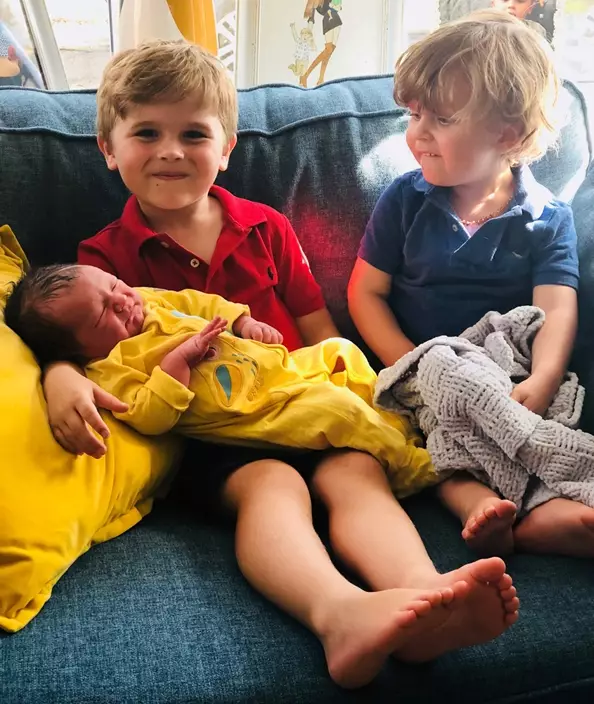
Newborn Henry with his brothers Freddie and Charlie (PA Real Life/Collect)
Now, Alex continues to use the products to keep Henry’s spots at bay and has also found them useful for Charlie’s eczema – as well as improving her own complexion.
She continued: “He gets the odd little spot, but now I just tell people it’s baby acne, and get it out there myself before they can say anything.
“He’s so much more comfortable now and such a happy little baby.”
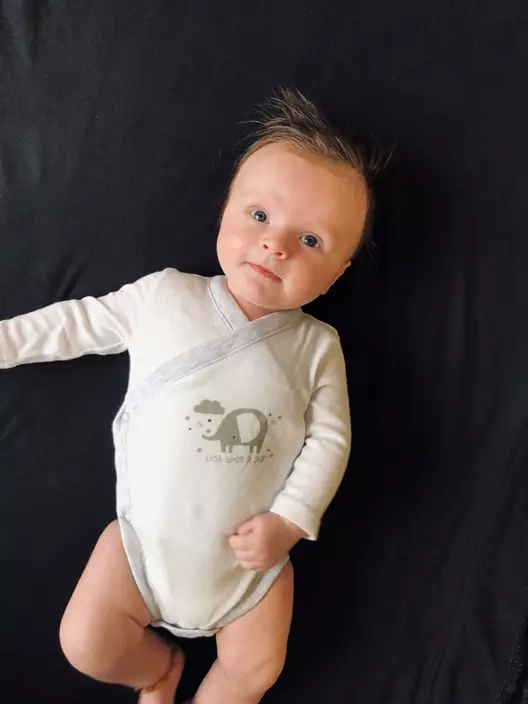
Henry now, with clear skin (PA Real Life/Collect)
Kokoso founder Lauren Taylor, 39, who discovered the benefits of coconut oil when her own baby daughter had dry skin problems, said: “When I found this lovely coconut oil helped my own daughter, I just wanted to share it with all other parents, so their own children could benefit too.
“I’m so pleased to hear it’s helped clear up little Henry’s spotty skin.”
AUGUSTA, Ga. (AP) — Camilo Villegas wasn't just trying to refine his golf swing as he prepared to play in the Masters for the first time in nine years.
He was constantly checking the fine print on the ingredients in sunscreen. It reached a point a few weeks ago when the 42-year-old Colombian was trying three brands — one for his face, another for his arms, a third for his legs during practice rounds when PGA Tour players can wear shorts.
Nothing is left to chance.
“The first one I realized was more of a cosmetic. It didn't really work as strong as I wanted,” Villegas said. “I'm trying a Korean brand now, and that has worked pretty good.”
Skin cancer has his attention — along with many of his fellow golfers.
There seems to be a renewed emphasis on sun protection. Golfers are more exposed to the sun for longer periods of time than players in any other sport. The weekday rounds last five hours. Throw in an hour of practice before the round, sometimes after, and it adds up quickly.
“The amount of time we spend in the sun, you've got to protect yourself,” Villegas said. “The sun is burning you.”
No need telling Stewart Cink. He was walking off the practice range at Innisbrook Resort in Palm Harbor, Florida, last month when he was asked why sun protection was important to him.
“Well, as someone whose maternal grandmother passed away from melanoma, and someone who's out in the sun a whole lot and someone who already had a big chunk of stuff cut off the side of my face,” he said, pausing to smile. “It very important, not to mention what my wife is going through with her (breast cancer) treatment. It would be dumb not to.”
The American Academy of Dermatology estimates one in five Americans will develop skin cancer. The non-melanoma variety, such as basal cell carcinoma and squamous cell carcinoma, affects 3 million Americans a year.
Sunscreen is just one form of protection.
Stephanie Kyriacou of Australia has always been conscious about the effects of the sun, but a turning point during her amateur days was meeting a woman at home Down Under who invited her to a factory in Queensland.
That was her introduction to Australia-based “SParms,” which makes sun protection sleeves that have become enormously popular on the LPGA Tour.
The sleeves are made of high-tech fabric with an ultraviolet protection factor (UPF) of at least 50, meaning it blocks 98% of the sun's ray. The sleeves can go up the arm and wrap around the shoulder blade.
“Like a lot of girls out here, I'm aware of my skin,” Kyriacou said. “Sunscreen on my face and SParms on my arms. And I like to wear pants unless it's boiling hot.”
Now there are some 60 players at any given tournament wearing sun sleeves.
Kyriacou estimates she's in the sun for at least seven or eight hours a day, and the 23-year-old Aussie has been playing since she was 4.
That's typical of most tour players. They have spent practically their entire lives in the sun, facing the ultraviolet rays that can cause so much damage.
Exposure to the sun’s ultraviolet light raises the risk of skin cancer, the most common and one of the most preventable types of cancer. The American Academy of Dermatology recommends using a sunscreen with a sun protection factor (SPF) of 30 or higher and one that is “broad spectrum,” meaning it protects against both UVA and UVB rays.
“I don't think I wore sunscreen ever,” Cink said. “You know, we use to wear suntan lotion or oil that would intensify the sun so you would get tan. I don't think I wore anything protective at least until I got on tour.”
It wasn't until he was 45 that Cink fully understood the danger. He had a basal cell carcinoma removed from the side of his nose in 2018. And now it's not just any sunscreen he uses.
“I am not a big fan of chemical sunscreen,” he said, referring to the more common brands. “I like the physical barriers, the zinc oxide and titanium dioxide. I look for something that has a high concentration of those two. You can find them if you search.”
Villegas found it on an app called Yuka, which deciphers product labels and analyzes the impact of food and cosmetics. That includes sunscreen.
“It's not perfect. You've got to do some analysis,” Villegas said. “But it gives you options. It's not like it takes you to a website to purchase something — that would make me skeptical. You compare products yourself and do the analysis.”
Skin cancer doesn't discriminate, so golfers of color also are seeking protection.
Xander Schauffele has darker skin, the son of a Taiwanese-born mother and a European father (French and German). He also uses the Yuka app and lately has been going with a product he calls Mr. Seaweed.
“It has less toxic stuff, I've been told by an app,” he said. “Sprays are bad. Cream is the best thing. I look up all that stuff.”
Justin Thomas, a two-time PGA champion whose father and grandfather were club professionals, said he has always used sunscreen, usually whatever is handy. Now he pays closer attention, and for good reason.
He said his legs and neck used to get hit pretty hard by the sun when he was practicing for long hours. He previously had five small moles removed as a teenager. But a tiny one on the back of his left leg concerned him in 2019 because of the odd color.
It turned out to be early stages of melanoma — the most dangerous form of skin cancer but curable if caught early — and he had surgery in which doctors cut down to the fat to make sure they got it all. The surgery left a scar across the back of his calf.
“I was 26 and my doctors are telling me I was months away from being a patient in the hospital,” Thomas said.
He wore sunscreen before. Now he is reading labels, paying particular attention to SPF and getting out the message that “you need to wear sunscreen and you need to get checked.”
AP Medical Writer Carla K. Johnson contributed to this report.
AP golf: https://apnews.com/hub/golf
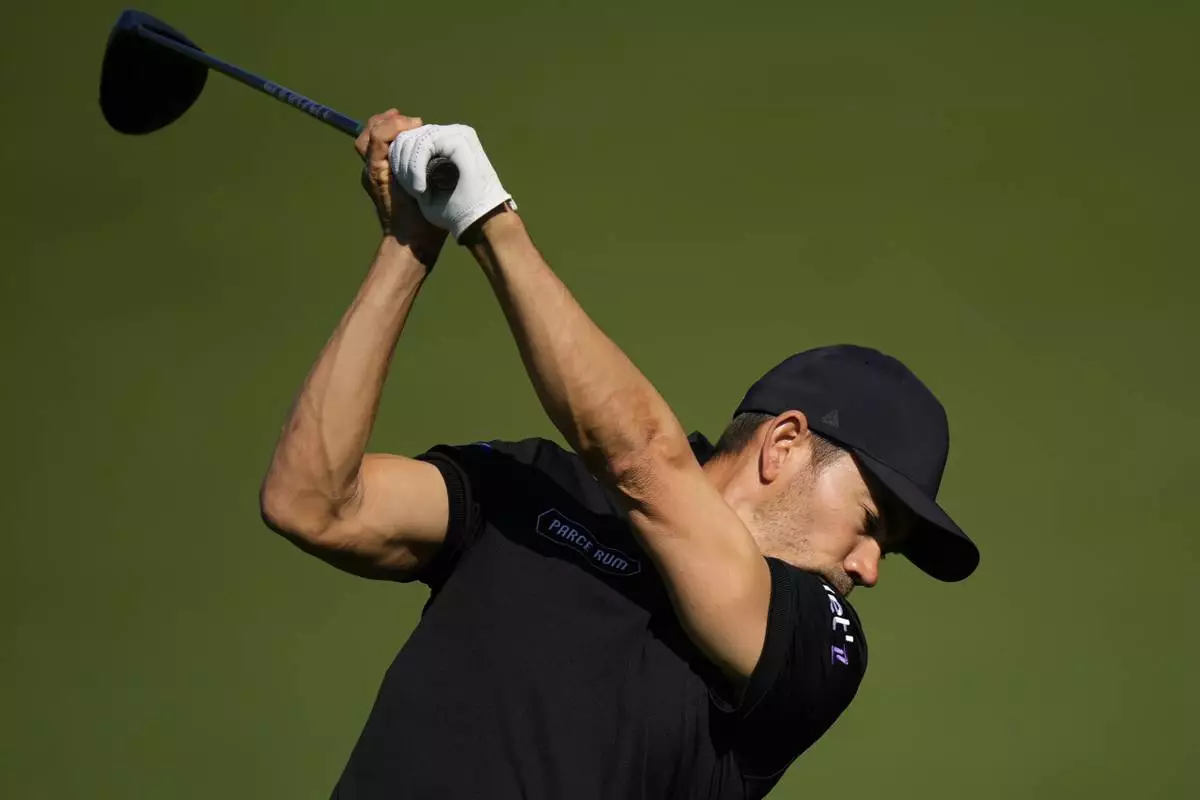
Camilo Villegas, of Colombia, hits on the practice range during a practice round in preparation for the Masters golf tournament at Augusta National Golf Club Monday, April 8, 2024, in Augusta, Ga. (AP Photo/Matt Slocum)

Camilo Villegas, of Colombia, catches a golf ball on the practice range during a practice round in preparation for the Masters golf tournament at Augusta National Golf Club Monday, April 8, 2024, in Augusta, Ga. (AP Photo/Matt Slocum)
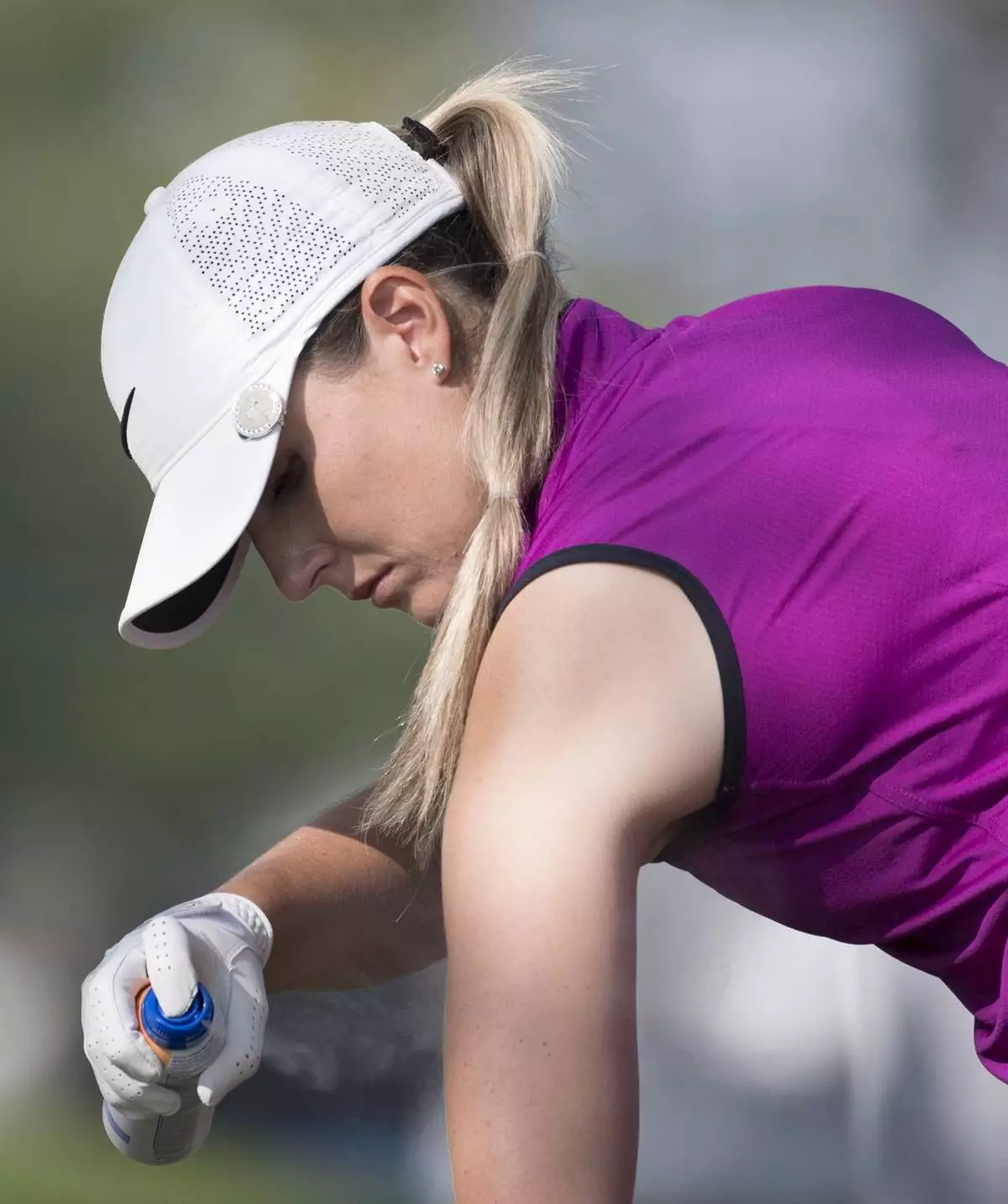
FILE - Megan Osland, of Canada, sprays on sunscreen during the first round of the Women's Canadian Open golf tournament in Regina, Saskatchewan, Thursday, Aug., 23, 2018. Golfers are in the sun as much if not more than players in other sport. It can be as many as eight hours a day. And there is renewed emphasis on protecting their skin. (Jonathan Hayward/The Canadian Press via AP, File)
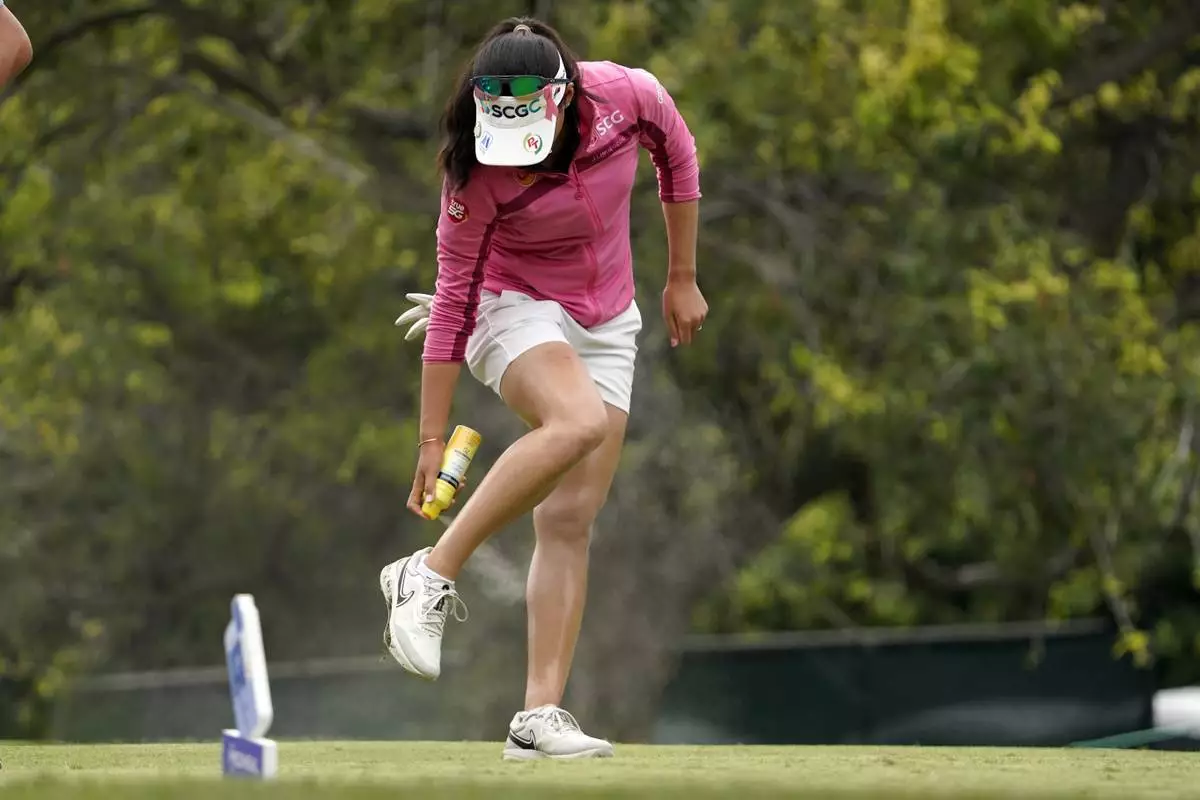
FILE - Atthaya Thitkul, of Thailand, sprays her legs with sunscreen on the third hole during the first round of the MEDIHEAL Championship golf tournament Thursday, Oct. 6, 2022, in Somis, Calif. Exposure to the sun’s ultraviolet light raises the risk of skin cancer, the most common and one of the most preventable types of cancer. (AP Photo/Mark J. Terrill, File)
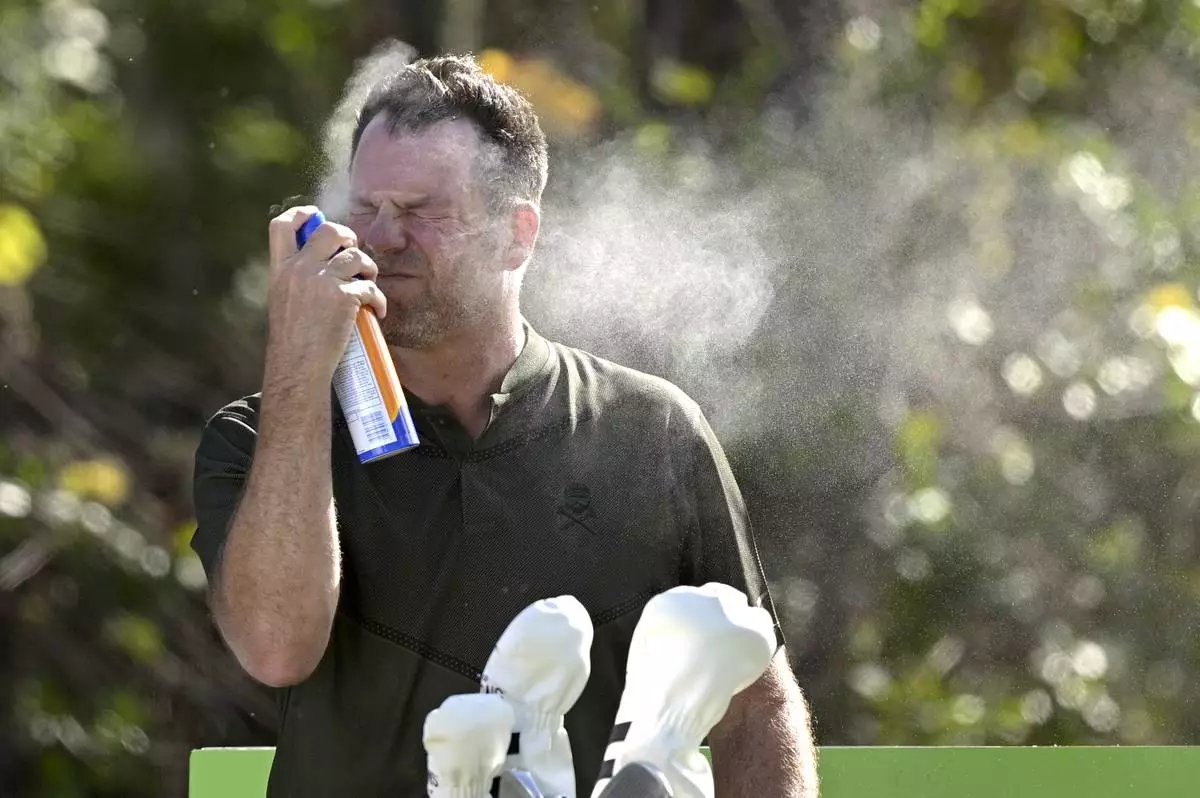
FILE - Mike Flaskey, CEO of Diamond Resorts International, sprays himself with sunscreen before hitting his tee shot on the second hole during the final round of the Tournament of Champions LPGA golf tournament, Sunday, Jan. 24, 2021, in Lake Buena Vista, Fla. (AP Photo/Phelan M. Ebenhack, File)
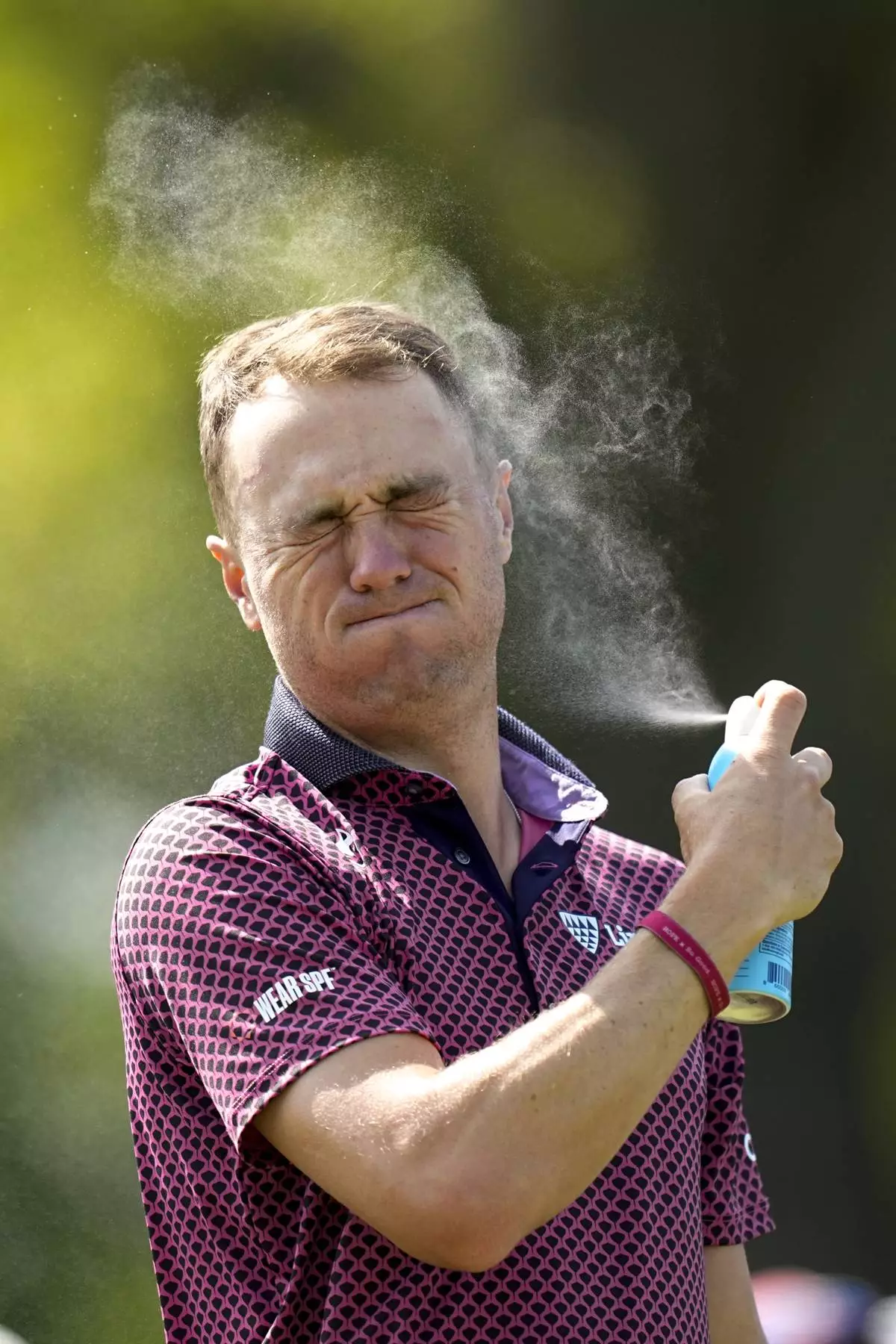
FILE - Justin Thomas applies sunscreen on the 11th hole during the first round of the PGA Championship golf tournament at Oak Hill Country Club on Thursday, May 18, 2023, in Pittsford, N.Y. Thomas, a two-time PGA champion whose father and grandfather were club professionals, said he has always used sunscreen, usually whatever is handy. Now he pays closer attention, and for good reason.(AP Photo/Eric Gay, File)

FILE - Stephanie Kyriacou, of Australia, tees off on the 13th hole during the first round of the ShopRite LPGA Classic golf tournament, Friday, June 10, 2022, in Galloway, N.J. Kyriacou has always been conscious about the effects of the sun. (AP Photo/Matt Rourke)

FILE - Jordan Spieth applies sunscreen during the first round of the SMBC Singapore Open golf tournament at the Sentosa Golf Club's Serapong Course Thursday, Jan. 28, 2016, in Singapore. Golfers are in the sun as much if not more than players in other sport. It can be as many as eight hours a day. And there is renewed emphasis on protecting their skin. (AP Photo/Wong Maye-E, File)
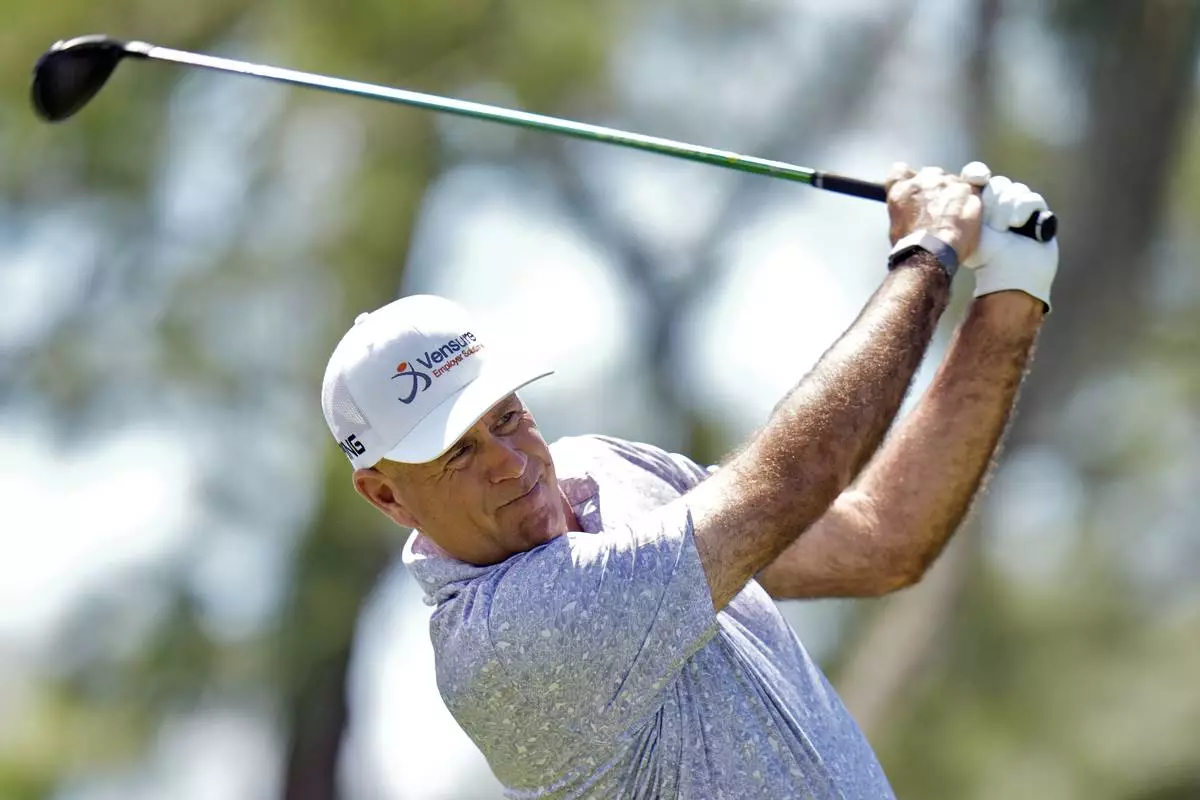
Stewart Cink tees off on the sixth hole during the third round of the Valspar Championship golf tournament Saturday, March 23, 2024, at Innisbrook in Palm Harbor, Fla. Golfers are in the sun as much if not more than players in other sport. It can be as many as eight hours a day. And there is renewed emphasis on protecting their skin. (AP Photo/Chris O'Meara)
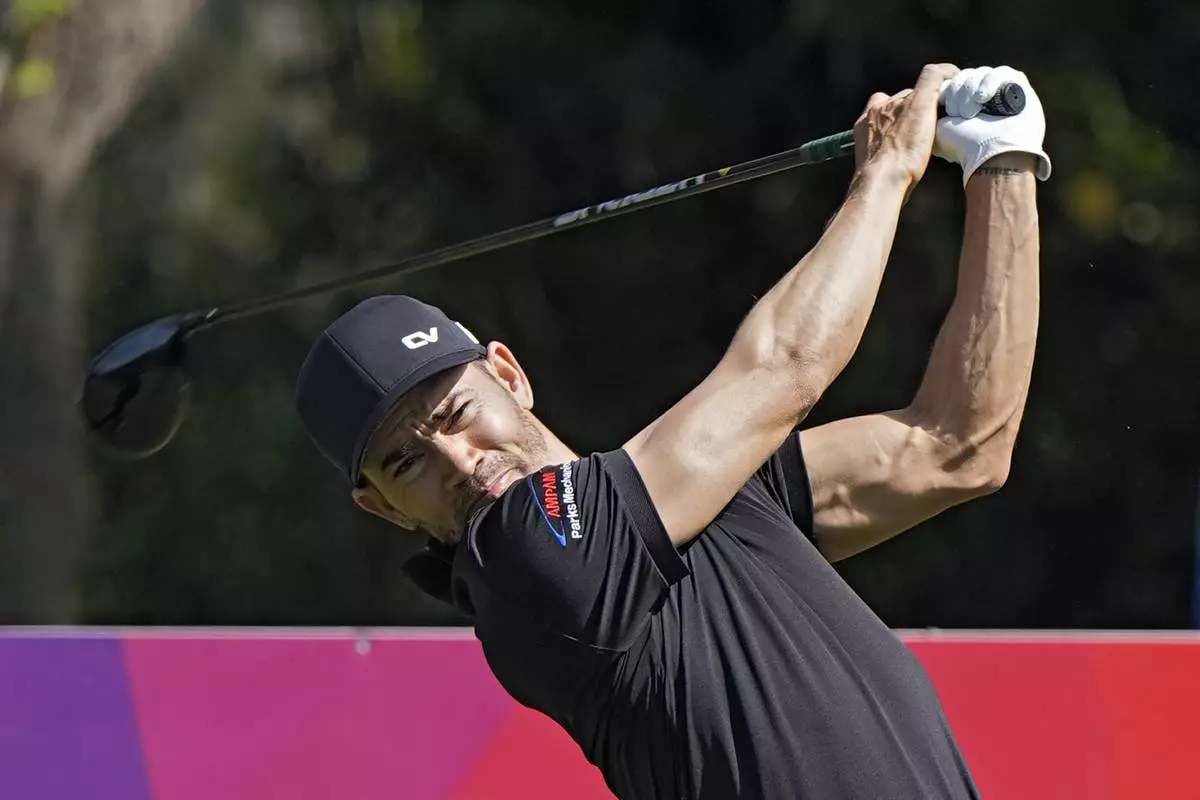
Camilo Villegas tees off on the 11th hole during the first round of the Valspar Championship golf tournament Thursday, March 21, 2024, at Innisbrook in Palm Harbor, Fla. Golfers are in the sun as much if not more than players in other sport. It can be as many as eight hours a day. And there is renewed emphasis on protecting their skin. (AP Photo/Chris O'Meara)






















